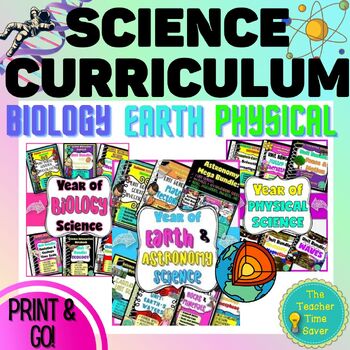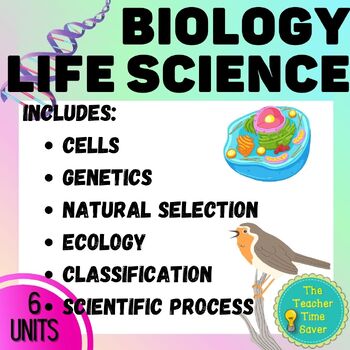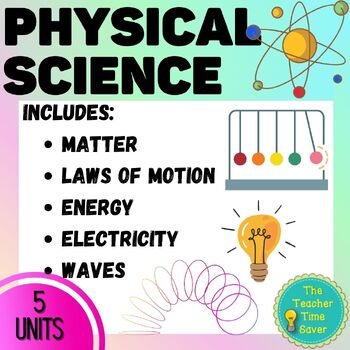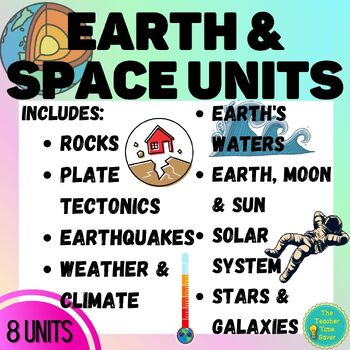NGSS Science Curriculum Year Bundle - Biology, Physical & Earth Science
- Zip
- Easel Activity
Products in this Bundle (246)
showing 1-5 of 246 products
Bonus
Description
This comprehensive Science Curriculum Bundle with 18 units is prepped and planned from start to finish with everything a science teacher would want while offering autonomy and flexibility.
Each unit includes 4-5 lessons each complete with a set of differentiated notes, a slide presentation to guide note-taking, a mini quiz to check for understanding, an activity to review after notes, and warmups with answer keys.
Each unit bundle also includes a word search, coloring/review activities, projects with directions and rubrics, easy-to-follow labs and templates, editable tests, editable versions of the notes and slide and more!
This resource includes all of the following:
MATTER ATOMS AND PERIODIC TABLE OF ELEMENTS
- Warm-ups
- Properties of Matter Lesson
- States of Matter Lesson
- Atom Structure Lesson
- Bohr's Diagram Lesson
- Atom Bonds Lesson
- Periodic Table Lesson
- Elements, Compounds, and Mixtures Lesson
- Chemical Reaction Lesson
- Phases of Matter Comic Project
- Atom Model Project
- Periodic Table Battleship Activity
- Chemical Reaction Restaurant Menu Project
- Matter and Chemistry Unit Assessments
- Editable Notes and Slides
- Warm-ups
- Lesson- Speed and Motion
- Lesson- Acceleration and Velocity
- Lesson- Force and Friction
- Lesson- Net Balances
- Lesson- Newton's Laws of Motion
- Activity: Obstacle Coarse Challenge
- Project- Trivia Board Game Review
- Editable Test and Quiz
- Editable Notes and Slides
- Task Cards
- Word Wall
- Warm-ups
- Lesson- Law of Conservation of Energy
- Lesson- Kinetic and Potential Energy
- Lesson- Work
- Lesson- Power
- Lesson- Simple Machines
- Energy Cartoon Project
- Lab: Kinetic and Potential Energy Ball Drop
- Editable Assessments
- Editable Cornell Notes and Slides
- Warm-ups
- Lesson- Electricity
- Lesson- Electrical Current
- Lesson- Electric Circuit
- Lesson- Batteries
- Lesson- Magnets and Electromagnets
- Review Project
- Test and Quiz with answer keys
- Editable Cornell Notes and PowerPoint
- Warm-ups
- Lesson- Waves
- Lesson- Property of Waves
- Lesson- Property of Light
- Lesson- Refraction and Diffraction
- Lesson- Sound
- Project- Trivia Board Game
- Test- Answer key & Reflection activity
- Editable Cornell Notes & Slides
- Warm-ups
- Lesson- Levels of Organization
- Lesson- Cell Organelles/Cell Structures
- Lesson- Prokaryotic and Eukaryotic Cells
- Lesson- Meiosis
- Lesson- Mitosis
- Project- "Wanted" Bacteria Poster
- Assessment
- Editable Cornell notes and Slides
- Biology Bingo Vocabulary Review!
- Warm-ups
- Lesson- Heredity
- Lesson- Genetics and DNA
- Lesson- Punnett Squares
- Lesson- Pedigree
- Project: Family Pedigree
- Editable Assessments
- Editable Cornell Notes and Slides
EVOLUTION AND NATURAL SELECTION
- Warm-ups
- Lesson- Natural Selection
- Lesson- Charles Darwin vs. Jean-Baptiste Lamarck
- Lesson- Geologic Time Scale
- Lesson- Human Evolution
- Lab Activity: Survival of the Fittest
- Cartoon Project: Natural Selection
- Unit Review Project
- Editable Assessment and Reflection Activity
- Editable Cornell Notes and Slides
- Warm-ups
- Lesson- Ecosystem Levels of Organization
- Lesson- Carrying Capacity and Symbiotic Relationships
- Lesson- Food Webs and Food Chains
- Lesson- Biomes
- Unit Review- Bingo Activity
- Project- Ecology Trivia Board
- Editable Assessment
- Editable Cornell Notes and Presentation
- Pre-Assessment/Warm-up
- Lesson- Classification
- Lesson- Kingdoms of Life
- Lesson- Dichotomous Key
- Lesson- Cladogram
- Bingo Unit Review
- Project- Classification Booklet
- Editable Assessment and Reflection Activity
- Editable Cornell Notes and PowerPoint
- Warm-ups
- Mineral Characteristics Lesson
- Mineral Identification Lesson
- Igneous Rock Lesson
- Sedimentary Rock Lesson
- Metamorphic Rock Lesson
- Rock Cycle Activity
- Rock and Mineral Cartoon Project
- Assessments- Test and Quiz with answer keys
- Editable Cornell notes and Slides
- Warm-ups
- Layers of the Earth Lesson
- Continental Drift Lesson
- Convection in the Mantle
- Sea-Floor Spreading Lesson
- Theory of Plate Tectonics
- Earth Model Project
- Plate Tectonics Worksheet
- Assessments- Test and Quiz with answer keys
- Editable Cornell Notes and Slide
- Pre-Assessment/Warm-up
- Earthquakes and Faults Lesson
- Measuring and Locating Earthquakes Lesson
- Seismic Waves Lesson
- Mapping Earth's Interior Lesson
- Tsunami Lesson
- Earthquake Crossword
- Earthquake Project: Newspaper Article
- Assessments
- Editable Cornell notes and Presentation
- Pacing Guide and teacher support
- Vocabulary Bingo Review Activity
- Warm-up
- Importance of our Oceans Lesson
- Ocean Waves and Tides Lesson
- Ocean Floor Features Lesson
- Surface Currents and Coriolis Effect Lesson
- Deep Ocean Currents Lesson
- Project- Ocean Diorama
- Earth's Waters Unit Test
- Philosophical Chairs Argument Activity
- Warm-ups
- Lesson- The Water Cycle
- Lesson- Earth's Atmospheric Layers
- Atmosphere Energy Transfer Lesson (electromagnetic spectrum)
- Wind Lesson
- Air Masses and Fronts Lesson
- Cartoon Project
- Assessments- Test and Quiz with answer keys
- Editable Cornell notes & Presentations
ASTRONOMY- EARTH, MOON, AND SUN
- Warm-ups
- Earth and Moon's Motion Lesson
- Seasonal Patterns Lesson
- Gravity in Space Lesson
- Moon Phases and Eclipses Lesson Free!
- Moon Causes Tides Lesson
- Astronomy Cartoon Project
- Assessments- Test and Quiz with answer keys
- Pacing Guide- Free!
- Editable Notes and Slides
- 10 Warm-up
- Lesson- Solar System
- Lesson- Sun
- Lesson- Inner Planets
- Lesson- Outer Planets
- Lesson- Comets, Asteroids, and Meteors
- Project- Solar System
- Assessments- Test and Quiz with answer keys
- Editable Cornell notes and Presentation
ASTRONOMY- STARS, GALAXIES, AND THE UNIVERSE
- Warm-ups
- Characteristics of Stars Lesson
- Hertzsprung-Russell Diagram Activity
- Life Cycle of Stars Lesson
- Stars Systems and Galaxies Lesson
- Big Bang Theory Lesson
- Astronomy Review- Trivia Board Game Project
- Philosophical Chairs Argument Activity
- Astronomy Vocabulary Riddle Challenge Game
- Assessments- Test and Quiz with answer keys
- Editable Cornell Notes & PowerPoint
- Notebook Set-Up
- Pre-Assessment/Warm-up
- Lesson- Lab Safety Lesson
- Lesson- Lab Materials and Measurement
- Lesson- Metric Measurements
- Lesson- Scientific Method
- Lesson- Controlled Experiment
- Lab- Water Drops on a Penny
- Activity- Scientific Method Cartoon
- Famous Scientist Wanted Project
- Assessments- Test and Quiz with answer keys
- Editable Notes and Slides
Stay connected to be the first to know about store discounts, free products, and product launches!
☆ The Teacher Time Saver Store
☆ Newsletter (free product when you subscribe!)
Terms of Use:
Copyright © The Teacher Time Saver. All rights reserved by author. This product is to be used by the original down-loader only. Copying for more than one teacher, classroom, department, school, or school system is prohibited. This product may not be distributed or displayed digitally for public view. Failure to comply is a copyright infringement and a violation of the Digital Millennium Copyright Act (DMCA). Clip art and parts included in the PDFs are copyrighted and cannot be taken and used outside this download without permission or license. Intended for classroom and personal use ONLY.





